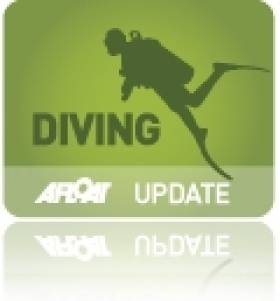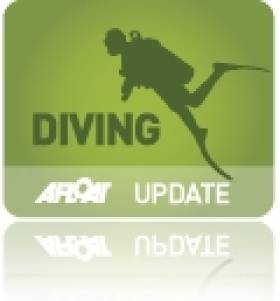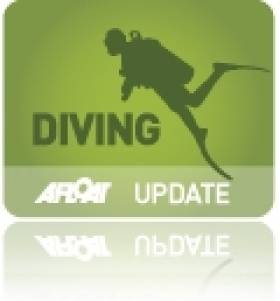Displaying items by tag: diving
Quarry Divers Airlifted for Treatment
Four divers were airlifted to hospital yesterday after getting into difficulty while exploring a flooded quarry in Portroe, Co Tipperary.
RTÉ News reports that one of the divers, a man in his 20s, was airlifted by the Shannon-based Coast Guard helicopter to Navy headquarters at Haulbowline in Cork, where he was treated in a decompression chamber.
His three companions were taken to Cork University Hospital as a precaution against decompression sickness.
A hospital spokesperson told the Irish Examiner that none of the group is in a serious condition, though all four are being kept under observation.
Ice Diving in Ireland
The recent arctic weather allowed many Irish divers to try out a type of diving that is only normally carried out in the Arctic, Norway, Iceland, Russia, Canada and much more Northern climates writes Timmy Carey. Many Irish rivers froze over completely, something that hasn't happened in recent living memory. This however is a hazardous form of diving as with thick ice if the diver cannot find the hole they entered they will drown if the ice is too thick to break and so they have a rope link to the hole. The other big hazard being hypothermia with the water being a very chilly two degrees celsius!, with most divers being thoroughly chilled after about 10 to 15 minutes. The big advantage
with this type of diving is generally that the visibility is excellent and allows a diver to try out ice diving without the cost of traveling to the arctic circle!
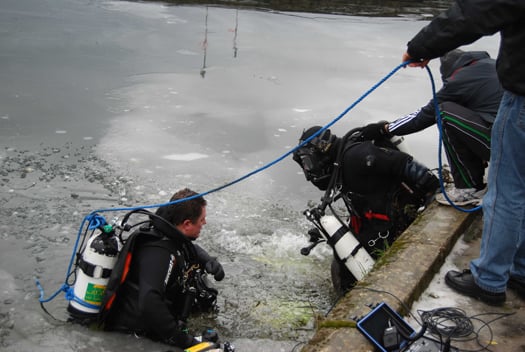

Stephane Portrait surfacing after a 20 minute dive under the ice of the river Blackwater in Munster
Lecture: "Historical Diving in Ireland"
The Maritime Institute of Ireland (M.I.I.) hosts a Winter /Spring lecture series. The first lecture of the new year is 'Historical Diving in Ireland' by Dr Edward Bourke.
The lecture is on 20 January and starts at 8pm and is to be held in the Stella Maris Seafarers' Club, Beresford Place. The club is located beside Busaras and faces opposite the rear of the Customs House. Nearby is the Irish Life Center (ILAC) which is convenient for car-parking and buses, the 'Red' Luas (Busaras stop) and DART stops at Connolly /Tara St. stations.
All are welcome, bar and refreshments and a voluntary contribution is appreciated. Further lectures will be held throughout the winter, mostly on the third Thursday of each month and in the Stella Maris. For further information about lectures and updates on the the M.I.I's maritime museum in Dun Laoghaire, logon to www.mariner.ie
Diving Asgard II
In September 2008 an iconic part of maritime Ireland silently and tacitly slipped beneath the surface of the Bay of Biscay near the idyllic island of Belle Isle writes Timmy Carey.
Asgard II was on a journey from Falmouth to La Rochelle for routine maintenance when it would succumb to its fate of a watery grave, thankfully captain Colm Newport was able to safely abandon the ship with the entire crew of 25.
Since 1981 Asgard II a beautiful brigantine designed by Jack Tyrell and built in Arklow had served the Irish nation with distinction all over the globe, providing sail training for over 10,000 people; the image of the bright green hull and white sails becoming synonymous with Irish sailing.
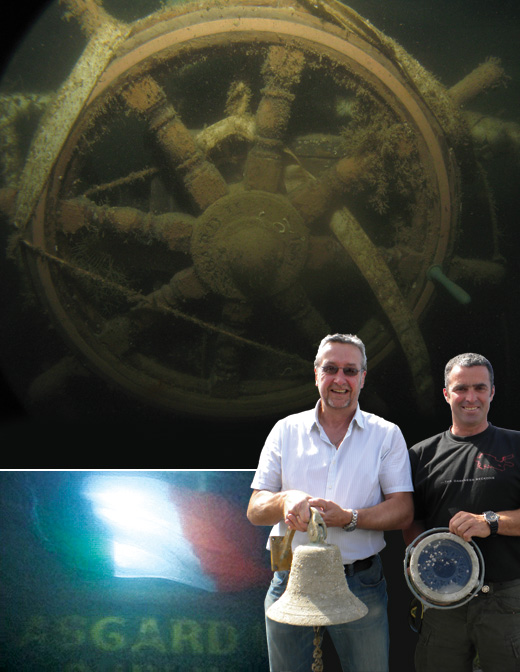
Main: Asgard's wheel prior to removal. Asgard campaigner Captain Gerry Burns (left) holds Asgard's bell with diver Eoin McGarry and the Tricolour defiantly draped on Asgard II
In addition to such a proud history, Asgard II also carried on the name and traditions of Asgard; which played such a pivotal role in Irish history and in the foundation of the state. In Norse religion Asgard was the home of the Norse gods and it is fitting that a vessel with such an auspicious name would later be called "the harbinger of Irish freedom" by the President of Ireland Eamonn De Valera.
Asgard was built in 1905 in larvik and was a wedding gift from Dr and Mrs Hamilton Osgood of Boston to their daughter Mary and her husband Erskine Childers (the father of the future president of Ireland). In a magnificent feat of seamanship (which was reminiscent of his famous novel the riddle of the sands) Erskine Childers in the company of his wife and others expertly collected arms from Hamburg and landed them in Howth on the 26th of July 1914 for the Irish volunteers. In one of the great ironies of Anglo-Irish history Erskine Childers a decorated British war veteran would become an avowed Irish republican and would play a crucial role in the struggle for independence as minister for propaganda (being very highly thought of by both Eamonn De Valera and Michael Collins); before being executed in the Irish civil war.
In 1961 the Irish government purchased the vessel for sail training and in 1968 Coiste and Asgard was founded and was assigned responsibility for the vessel. With the launch of Asgard II, the original Asgard was transferred to the national museum where it has been expertly restored to its original glory and will in the future be available for general viewing.
With such a rich maritime heritage and being so deeply engrossed in Irish history popular view in late 2008 was that the Irish government would salvage Asgard II as a symbol of Irish pride; alas it would later be decided by the Irish government to abandon Asgard II with the uniquely Irish bowsprit of Grainne Uaile condemned to a permanent watery grave on foreign shores.
As with many diving expeditions, they often begin with a simple conversation and one late night a phone call from Eoin McGarry would begin with "what do you think of diving the Asgard II next year". Soon the idea generated its own momentum and a small team of Irish trimix divers (all of whom are CFT members) was assembled and preliminary plans were made for July 2010.
Despite the fact that no permission was necessary to dive the vessel under Irish or French law, it was decided to notify the Irish government of dive teams intentions to video the wreck and recover some of the artefacts for the Irish people. On contacting Coiste an Asgard the reaction of the board was very negative indicating that the artefacts were of little value and that due to the depth involved they were not in favour of any dives taking place.
A little disillusioned it was decided to make representations directly to the Minister for Defence and soon a government TD with a real interest in Irish history discussed the idea with the Minister for Defence Willie O Dea.
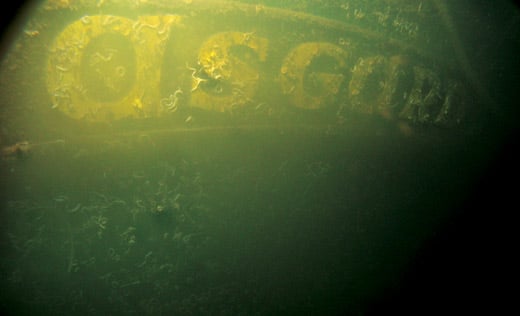
The ships name looming out from the darkness
In early February the dive team would receive a personal letter from the minister indicating that "enquiries are being made into the matter and I will write to you again shortly". In addition a TD had also confirmed to the dive team that the minister had indicated that he thought it was a great idea and wished the dive team well. Unfortunately within a very short time period the minister had to resign and the dive team received no further correspondence.
With the Irish government engrossed in an economic recession of epic proportions, the dive team decided to proceed before the ships artefacts were removed by foreign dive teams and lost to the state forever.
With time ticking by the final team of Eoin Mc Garry as expedition organiser, Brendan Flanagan of Longford Sub Aqua club, Phil Murphy and Frank McKenna both of Kilkenny Sub Aqua and myself were assembled as the bottom divers. With an emphasis on keeping the costs down as the divers would be financing the trip, the decision would eventually be made to have one cover diver to help the divers kit up and look after all the surface logistics; this would also allow all the dive team travel together in the one vehicle and reduce the travel costs. Being a qualified mixed diver as well as native of Brittany; Stephane Portrait of Blackwater Sub Aqua Club would become an essential member of the dive team without whom the trip could not have been successful.
Over the coming months Stephane and Eoin would work tirelessly on the logistics, which would be vastly more onerous and detailed than an expedition to the Lusitania. As well as the small issues of organising ferries, accommodation, a dive centre and a dive boat; the dive team would also notify in writing the local mayor of Belle Isle, the local tourist office, the local lifeboat and the admiral of the French national lifeboat institution in Paris, the local council and the head admiral of the Atlantic fleet of the French navy of the dive teams intentions.
Our dive boat skipper Yann Quere being the secretary of the French national sailing organisation and a Moniteur 3 with FFESSM (the French equivalent of CFT in CMAS), would be of huge assistance and confirmed to the dive team that there were no restrictions in diving the wreck. In addition the Irish government had not even requested an exclusion order be placed on the site to preserve the Asgard II, meaning it could be legally dived by any dive team at any time.
During the last few weeks endless hours would be spent reviewing the vessels plans, photographs and video clips; trying to decide what obstacles could lay ahead in trying to video and photograph the wreck as well as removing the bell, helm and compass. Eoin would even go so far as contacting Tyrell's to get the specifications of how the wheel was fitted and what size bolts were used to bolt the bell on.
A specialist dive tool bag was then assembled with all anticipated tools colour coded and placed into the bag in the order of their anticipated use; to try and eliminate wasting any precious bottom time. Only a few weeks to go and word came that a French technical dive team also had their eyes set on the Asgard II, would we arrive to late and would all the artefacts have disappeared into the possession of French or British divers; only time would tell.
Being Jury president of the CFT Moniteur 3 test on Inisboffin the day before the trip to France, my preparation time was hardly ideal; getting home after 10 pm on Friday then having to blend several mixes and assemble camera and rebreather equipment; grab a precious five hours sleep and head for the ferry. Seeing familiar faces of friends and dive buddies all thoughts of fatigue soon evaporated in anticipation of a good weeks diving. During the last week Paddy Agnew also joined the group and would assist Stephane on the surface during the course of the week.
Arriving in the idyllic harbour of Belle Isle the sight of the Irish Tricolour flying from the tourist office on our behalf was a good omen. That evening our skipper told us the water would be warm, the sea flat calm and visibility would be at least 10 meters with ambient light at depth; and we headed to bed in good spirits for an early start. Leaving the harbour with a strengthening breeze we would soon be greeted by a stiff force five and with cylinders rolling around at the stern of our dive boat; conditions were marginal as a small blob at 84 meters showed up on the screen of the GPS.
Our next concern would be the number of prawn trawlers that were fishing quite close by in the direction we anticipated our decompression station moving. With the Bay of Biscay having notoriously unpredictable weather it seemed that we would be treated to diving conditions more reminiscent of the south coast of Ireland. After an arduous time kitting up in a pitching sea in a dive boat, which doesn't normally cater for technical divers; the cooling effect of the sea came as welcome relief as Eoin Mc Garry and I dived first. Eoin would be taking video footage and I would be taking stills with my Ikelite camera housing rated to 60 meters, hopefully it would not leak at 84 metres! (at least the strobe was rated to 90 meters).
Dropping through layers of water the temperature soon dropped from 19 on the surface to 9 degrees Celsius at depth, the biggest surprise however being the visibility. Beyond 60 meters ambient light disappeared and visibility reduced to less than 1.5 meters; Irish diving conditions indeed. Landing on the Asgard II we could immediately see that our anchor line was perilously attached to the wreck and in danger of coming loose: something that was soon rectified. After adapting ourselves to the conditions it was good to see that my camera was surviving at 9 bar (at least for the moment) and we soon set off taking footage with Eoin taking video. Dropping down past the stern came the worm encrusted letters of Asgard II and swimming the length of the vessel it was soon apparent that she was in a sorry state. Both masts had collapsed and she had been badly damaged by trawlers; with one mast landing on the compass binnacle and the roof of the chart completely missing and almanacs aplenty neatly stacked in the shelves.
Amid the books and almanacs and nestled with a menacing grimace a large conger eel now stood sentinel in its new citadel. At the bow area it was a sorry sight to see the bowsprit of Grainne Uaile partially hidden by old sail, doomed forever to the seafloor. Swimming astern the sight of the ships helm still lashed was an amazing image that would cause all divers to become exuberant and all too soon our precious bottom time had elapsed and it was time for the mandatory 2 hours of decompression. Passing the second dive team who were also taking video footage the warm thermo clime was a welcome change from Irish diving conditions, but a strong surface current soon tempered that dramatically.
Back at the decompression station it was a strange sight to see that the strength of the current had orientated the decompression station at a 45-degree angle and instantly knew that the first hours decompression would be far from comfortable (until the second dive team had set the decompression station free in the current). Looking across at Eoin I could see the sight of the ships compass nestled safely in a bag, eliminating one of the objectives for day two. Surfacing to warm sunshine and with greatly moderated sea conditions we were soon planning dive objectives for day 2, pondering the difficulties of removing the ships bell and helm.
On unloading the boat back at Belle Isle we would have two groups of visitors, both unexpected. The first group were survivors of the sinking who had returned to Belle Isle sailing aboard the magnificent Le Belem and soon we were showing them the footage of the vessel they so hastily had to abandon.
The sight of two gendarmes taking to Stephane had the rest of us wondering what was happening, when it quickly emerged that a complaint had been received by the French police from an Irish government agency asking for the diving to be halted. While the rest of us blended gas and organised logistics for day two, Eoin and Stephane had very cordial discussion with French gendarmes who said we might not be able to dive the wreck later in the week.
The next morning with a 6 am start we were soon heading for the wreck site (with the Irish tricolour again flying from our dive boats mast) and were soon onsite. With the possibility of only one dive left on the Asgard II, dive objectives had to be reassigned and all divers were again assigned to two dive teams and we were soon descending a shot line in strong currents.
Approaching the ships hull seeing bubbles coming from my cameras strobe were not a welcome sight and I wondered would it work filled with seawater and found it did. The camera housing rated to 60m meters survived both dives unscathed; with the expert advice I had received on underwater photography earlier in the year from Ivan Donoghue, Simon Carolan and Nigel Moyter proving invaluable on the trip.
During this dive the dive team would again get video footage, which was given to the marine casualty investigation board for their report as well as getting more stills footage. Frank Mc Kenna soon had the ships bell and bracket removed and soon it was attached to a lifting bag and heading for the surface 84 meters above. Eoins' huge amount of prior research was soon hugely rewarded when the ships helm was also heading to the surface where Stephane Portrait was waiting to recover them.
The final act of the dive team would be to leave an Irish tricolour on a vessel whose name has such symbolism in Irish history, when Irish men and women overcame impossible odds to defeat the greatest empire on the globe to establish an Irish state after 700 years of struggle. The tricolour left draped on the wreck had been a gift from an ex member of the Irish Defence Forces and had last flown over and Irish Military Establishment and would serve as a fitting tribute to a vessel that had so eloquently represented Ireland in a maritime setting. Back aboard our dive vessel it was good to see that everyone had completed their decompression safely and that all objectives had been completed, with Stephane doing Trojan work for the bottom divers.
Once back ashore we would be astounded to hear of sensationalist newspaper headlines back home; giving a completely inaccurate version of events. That evening Eoin and Stephane would declare the artefacts to the equivalent of the French receiver of wrecks and would be told that the matter had been referred to the commodore of the local French naval base in Brest.
The following day the gendarmes would give the dive team a copy of a fax from the French naval base which confirmed that the dive team had broken no laws French or otherwise as we had known all along and the French gendarmes apologised for any inconvenience caused (that they had been acting on a fax from an Irish government body which was furnished to the dive team) and wished the dive team well.
Over the next few days of pleasure diving shallower wrecks two surprises would arise; the first that the visibility at the other end of the island was in stark contrast to that where the Asgard II lies and was typically twenty meters at depth!!! and secondly that the artefacts that we had previously been told were valueless were now suddenly of huge interest to Coiste an Asgard. Indeed it would puzzle everyone on the dive team at how helpful the French authorities were which was in stark contrast to their Irish counterparts; whom it would seem would have preferred to see these items disappear into the hands of continental or British dive teams. In the interim Eoin had got expert archaeological opinion in how best to preserve the wheel and spent a considerable sum of his own money in making a specialist box to ensure we could transport it in a wet condition back to Ireland.
Once back home the huge cascade of congratulatory messages to the dive team was a nice boost and made all the financial and personal sacrifice very worthwhile, as the volume of people with an interest in Irish maritime affairs soon became apparent. Back on Irish soil, the artefacts were registered with the Irish receiver of wrecks and handed over to him in custody as per maritime and salvage law. Hopefully in time these symbols of Irish maritime history and pride will be put on permanent display in a fitting venue such as the national museum next to the original Asgard or in Dun Laoghaire at the national maritime museum; where the 10,000 trainees who first learned to sail a tall ship aboard Asgard II can again hold that famous wheel or ring the bell.
Kozlowsk Lecture on Cave Diving in Ireland
Of all aspects of scuba diving, the discipline with the highest mortality rate is cave diving writes Timmy Carey. A myriad of things can go wrong, a diver can get lost, run out of air and even worse, carried out in complete darkness if the diver loses their lights. On Friday, the 3rd of December N.U.I.G G.M.I.T Sub Aqua club will be hosting a free lecture on cave diving. The lecture will be presented by Artur Kozlowski and has made a large number of caving breakthroughs in Irish cave systems.
In 2008 he broke the British and Irish depth record in a cave at 103 meters and the lecture promises to be very interesting. The venue is D'arcy Thompson (on the main concourse) in N.U.I Galway.

Historic Lecture on the Easter Rising Vessel, The Aud
Embedded in the history of Ireland, the events which occurred in April 1916 place Roger Casement and his famous gun running ship in the annals of Irish history. She lies broken, in a depth 34 metres in Cork Harbour. Much of the cargo of 20,000 guns and 1,000,000 rounds ammunitions still remain writes Timmy Carey. The ship was scuttled by her captain Karl Spindler rather than hand the cargo to the British. This would be the only German naval surface ship to enter Irish waters during World War 1. The wreck was depth charged on a number of occasions to make sure that the weapons were scattered and made unrecoverable by rebel forces and to prevent submarines using the wreck as cover. The rifles and much of the ammunition originated in Russia. They were captured as a result of the rout of Russian forces at the battle of Tannenburg in 1914.
This coming Friday night Blackwater Sub Aqua Club in Fermoy will host a lecture on the Aud by author Xander Clayton. Xander is a researcher of Modern Irish history and is the leading authority on the Casement Ship. He has made a detailed study of the ship and her 22 man crew over the past quarter century, culminating with the publication of the book "AUD" in 2007. He now lives in Ireland and the second edition of his book is due for imminent publication. The lecture will start at 20:00 and is free of charge. The venue is Blackwater Sub Aqua Clubhouse, Rathealy Road, Fermoy. For further information contact Matthew Culotty 087-8217069.

Xander Clayton author of the book "Aud"

An image of the Aud ship before she was scuttled at the entrance to Cork harbour where she lies today

Karl Spindler the German captain of the Aud
Dundalk Divers Pay Tribute to 20 Lost on SS Dundalk in 1918
On the 14th of October 1918, 20 people from Dundalk lost their lives aboard SS Dundalk when it sunk 60 miles south of the Isle of Man writes Timmy Carey. Earlier this year to mark the 92nd anniversary of the loss a number of Dundalk Sub Aqua Club divers carried out a commemorative dive to the wreck and laid a plaque of remembrance sponsored by Dundalk town council.
The team also placed an air tight capsule containing objects from the relatives of the survivors and those lost on the tragic ship.
Some artifacts were removed from the wreck and brought home to Dundalk and the team donated them to the local museum where they made a presentation of the expedition and showed some underwater footage of the wreck in its current state. The presentation was held on 14th October to mark the 92nd anniversary of the sinking and the team were joined by some relatives and members of the public for an emotional night with prayers and music provided by Fr Clem McManus a local Redemptorist Priest.
Read or hear the story of the SS Dundalk on their website HERE
Photos below courtesy of Paddy Agnew, Dundalk Sub Aqua Club
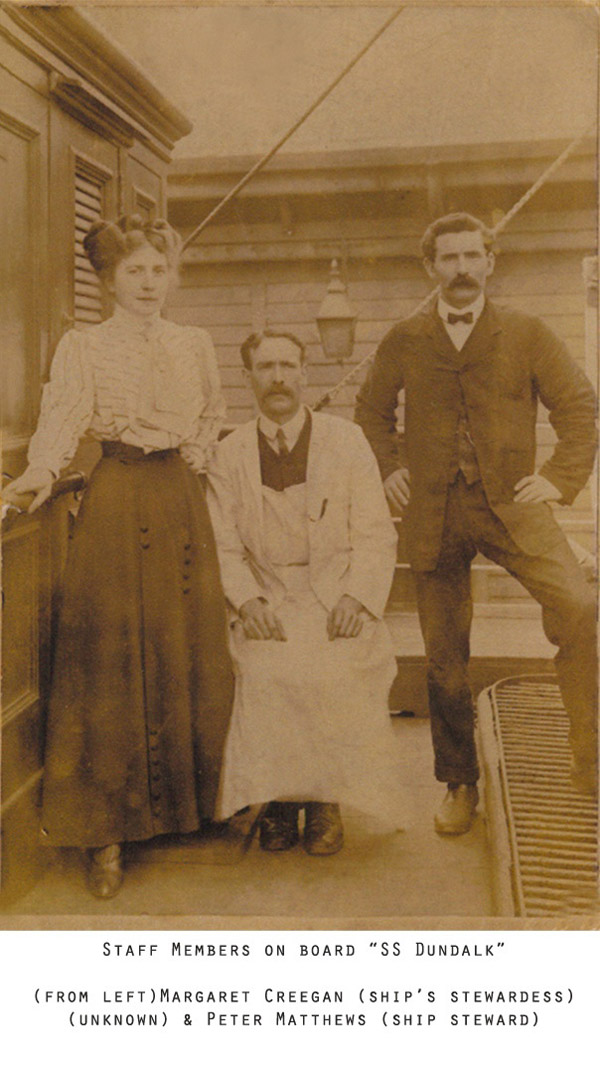
Local townsfolk who were lost on The SS Dundalk
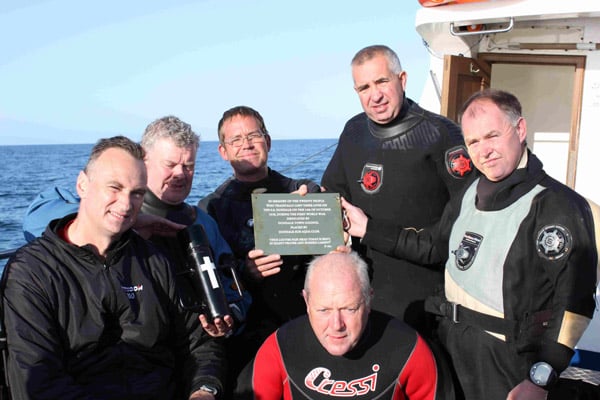
Members of Dundalk Sub-Aqua dive team before making their descent to the wreck of the SS Dundalk

Boru Dive Unit

Boru Dive Unit
The principal activities of the club include diving, search and rescue and powerboating.
Boru Dive Unit, c/o Jason Kenny, Shanley, Inchdrinagh, Ballina/Killaloe. Email: [email protected]
Have we got your club details? Click here to get involved
Irish Water Safety is the statutory body established to promote water safety in Ireland. Their role is to educate people in water safety best practices. They develop public awareness campaigns to promote necessary attitudes, rescue skills and behaviour to prevent drownings and water related accidents. Activities include:
Teaching swimming and lifesaving courses to children and adults. Recipients build skills in swimming, water confidence, safety, survival, rescue skills and resuscitation. Participants can progress to qualify as Pool and Beach Lifeguards, there are 27 qualifications that are internationally recognized and are available to children and adults nationwide.
Lectures and demonstrations to members of the Public and other interested parties.
Publishing literature to promote water safety and target at-risk groups. Popular posters include safe boating, safe swimming, and lifejacket posters. A Cold shock/hypothermia leaflet is also available as are many other publications.
Volunteers carry out Risk Assessments on all Bathing Areas nationwide, free of charge in order to make them safer by the erection of ring buoys, signage and other necessary action. The Local Authorities are most helpful in this regard.
Advise and assist Local Authorities on all matters relating to water safety.
The Nation’s Beach Lifeguards are tested by IWS examiners for the local authorities, free of charge prior to the annual summer season.
A programme exists in which National School teachers are coached in teaching water safety principles to their pupils.
Training all the boats crews for the Inshore Rescue Boat Service nationwide. The IWS also train and examine the Coast Guard Inshore Rescue Boats crews.
Promoting water safety along with other members of the Marine Safety Working Group and the Irish Marine Search and Rescue Committee.
National and local media actively communicates IWS safety messages to the public.
Issuing advice on all aspects of water safety. Press Releases are available all year round, which target the seasonal hazards on Irish waterways.
Organising the Annual National Lifesaving Championships; some members thn go on to compete in international events each year.
Awarding the ‘Just in Time’ Rescue Award to rescuers nationwide; other awards recognise work promoting Water Safety in Ireland.
The IWS develop a partnership approach with private sponsors to deliver safety messages to the public.
Providers of information on the locations of Lifeguarded beaches in Ireland.
History of Irish Water Safety
Before 1945, life-guarding was confined to a few counties in Ireland – that is, in Wexford, Waterford, Cork, Dublin and Clare. Indeed, the teaching of swimming and water safety as we know it was done on an ad hoc basis around the country, but mostly in the cities of Dublin and Cork where indoor swimming pools were available. It was only when a member of An Garda Síochána, Mr Harry Gillespie (who was Chairman of a small Water Safety Committee in County Clare) decided to approach the Irish Red Cross Society in May 1945 that Water Safety was established in Ireland on a formal basis.
Under the auspices of the Irish Red Cross Society, local Area Water Safety Committees were established in all of the counties of Ireland. Naturally, there was very little expertise in this country in the matter of water safety and swimming rescue, so it was decided that the American Red Cross should be approached as they had an excellent Water Safety Service running in the USA for many years. From them came the necessary approach to teaching water safety, then generally known as swimming rescue. Their booklets were also used as the basis for the first water safety manuals published by the Irish Red Cross Society (Water Safety Service).
It is worthy of note that several present members are recipients of the ‘Service Medal of Honour’ being founding members of the Water Safety Organisation in Ireland. For twenty-six years, Water Safety operated under the auspices of the Irish Red Cross Society and it was during this period that the structure of Examiners, Instructors and other voluntary (non-technical) personnel was established. During those early days, there were few indoor swimming pools in this country for the teaching of swimming and lifesaving. Much of the work was done during the Summer months at piers, quays, beaches, on riverbanks, and at lake sides. It was also during those first twenty-six years that we saw the increase in the use of lifeguards around the coast of Ireland during the summer. It must be remembered that few people could swim and fewer still could swim and save a life. Indeed, in many of the coastal towns and villages, particularly where their livelihood was derived from the sea, there was an old superstition, that it was better not to learn how to swim as it only prolonged the agony in the water when in difficulty.
Change was slow due to a lack of resources, but voluntary commitment was strong among the members, as it is to day. With time, improvements followed and a more conscious awareness of water safety began to unfold throughout the country, particularly as the seventies approached and the work of the Water Safety Service expand to every county throughout the country. The leading light at that time was a man called Plunkett Walsh, an employee of the Irish Red Cross Society with special responsibility for Water Safety. His great enthusiasm was an inspiration to all involved in the Water Safety Service to promote water safety awareness. However, his untimely and sudden death left a great void within the organisation.
Following this, in 1971 an approach was made to the Minister of Local Government who agreed to the establishment of the Irish Water Safety Association under the auspices of the Department of Local Government. This move was universally welcomed, albeit tinged with certain sadness on leaving the Irish Red Cross, with whom water safety had been for twenty-five years. The first Chairman of the Irish Water Safety Association was Mr Desmond Kenny who was from Galway.
With the establishment of the Irish Water Safety Association came an upsurge in membership, to meet the growing demand for swimming and lifesaving instruction throughout the country. In turn, this demand led to the construction of many indoor swimming pools and improved bathing facilities in many parts of Ireland. Shortly after the establishment of the Irish Water Safety Association, it was invited to join both Federation International De Sauvetage and World Life Saving, both international bodies dealing with water safety and rescue.
In 1987, a Government decision was made resulting in the IWSA being amalgamated with fire and road safety under the auspices of the National Safety Council. The members continued to give exceptional time and effort on a voluntary basis to ensure that swimming and lifesaving was taught nationwide and Water Safety went from strength to strength and the number of voluntary members involved continued to grow. Certificates issued for swimming and lifesaving increased annually, and the ‘Water Safety Awareness’ campaign was promulgated nationwide. With the encouragement of the National Safety Council, water safety personnel played an active role in the formation of the new International Life Saving Federation, which was established in 1994.
1995 was the 50th anniversary of the formation of Water Safety under the auspices of the Irish Red Cross, the Irish Water Safety Association and the National Safety Council. To mark this occasion, a suitable medal was struck to honour those who had given long and valued service throughout those fifty years. In November 1996 at a meeting of the Board of the National Safety Council, it was agreed that Water Safety be known as Water Safety Ireland. In the National Budget of 1998, it was announced that the Government had set a side the necessary finance to re-establish Water Safety as a singular organisation. The effect of this decision being that Water Safety was to leave the National Safety Council. The decision to establish Water Safety as the Irish Water Safety Association with its Headquarters in Galway took effect in November 1999. A Council of 12 persons was appointed with Mr Frank Nolan (a retired member of An Garda Siochana) being appointed as Chairman. The functions of the new body are similar to those that have been traditionally carried out over the past fifty-five years.
The new Association, which is the Statutory Water Safety Body for Ireland, is financed by Government, Local Authorities, fund-raising and sponsorship. The Association continues to be actively involved with International Life Saving (the world body) and co-operates with the other national organisations involved in water safety and rescue.
On the 25th August 2000, in front of a large audience, Minister of State, Mr Robert Molloy, TD, opened the new Headquarters of Irish Water Safety close to the Spanish Arch in Galway City. Irish Water Safety is governed by the Council, which is appointed by the Government for three years, supported by a full-time permanent staff. The functions of the Association are supported nationwide on a voluntary basis through 28 area Water Safety Committees and two special Committees (one within the Irish Police Force and the other within the Defence Forces). Persons who give exceptional Service over 25 to 50 years receive the ‘Medal of Honour with Bar’. Persons outside the Association, who have been supportive of Irish Water Safety over a number of years, can be honoured with a Life Governorship of the Association. Ten persons so far have been conferred with this honour.
The Irish Water Safety Motto: 'Every Person a Swimmer and Every Swimmer a Lifesaver'
Irish Water Safety (IWS), The Long Walk, Galway. Tel: 1890 420202, Fax: 091 564700, Email: [email protected]
Other IWS Afloat posts here:


























